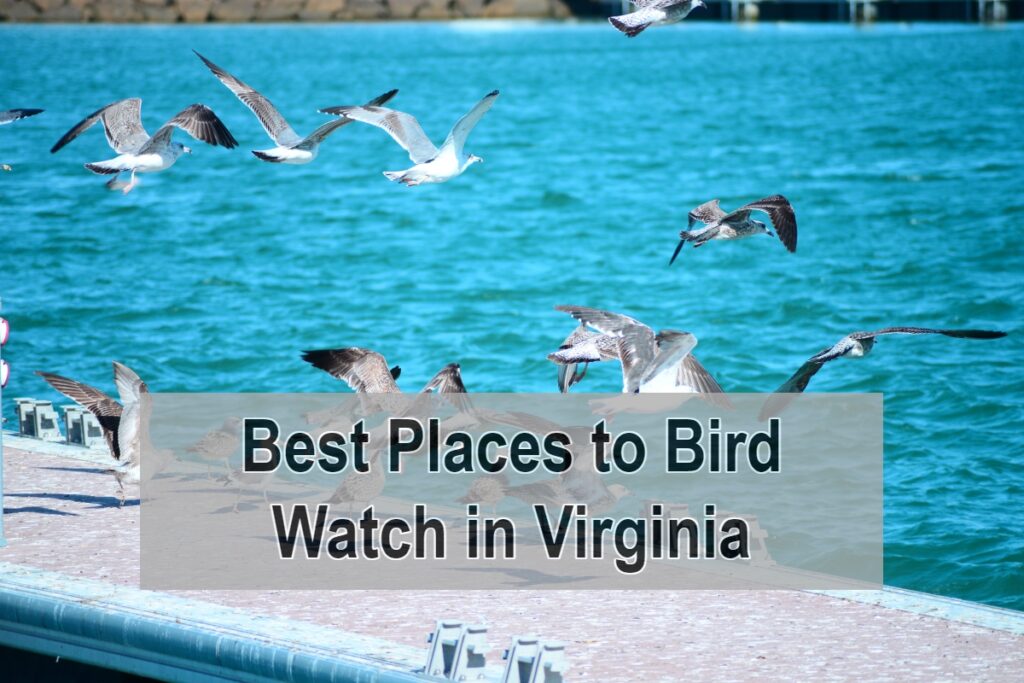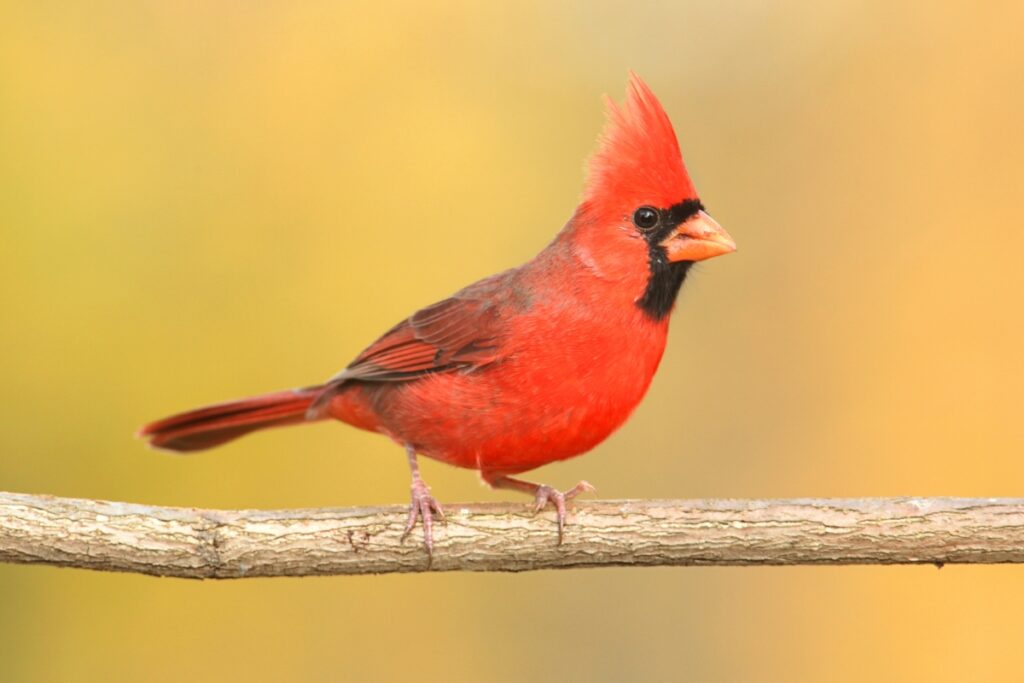As an Amazon Associate, we earn from qualifying purchases with no additional costs for you.
Virginia is a state in the southeastern United States, between Maryland in the north and North Carolina in the south. I wrote this blog to help you know the best birding spots in Virginia so you can have a successful bird watching trip when you visit.
Virginia’s best bird watching spots include those with diverse habitats, such as Virginia National Wildlife Refuge, Greensprings Nature Trail, and Black Bay National Wildlife Refuge. Kiptopeke State Park and the Shenandoah National Park are also excellent birding spots.
A table giving the most exciting birds you can see at each of my top 10 birding spots in Virginia:
| PARK | INTERESTING BIRDS YOU CAN SEE |
|---|---|
| Black Bay National Wildlife Refuge | Osprey and Bald Eagle |
| Huntley Meadows Park | Virginia Rail and Yellow-crowned Night Heron |
| Kiptopeke State Park | Peregrine Falcon and Golden Eagle |
| Chincoteague National Wildlife Refuge | Snow Goose and Tundra Swan |
| Virginia National Wildlife Refuge | Brown Pelican and American Wigeon |
| Dyke Marsh Wildlife Preserve | Least Bittern and Warbling Vireo |
| Greensprings Nature Trail | Scarlet Tanager and Orchard Oriole |
| Great Dismal Swamp National Wildlife Refuge | Pileated Woodpecker and Barred Owl |
| Shenandoah National Park | Ruffed Grouse and Common Raven |
| Dutch Gap Conservation Area | Green Heron and Hooded Merganser |
Read further to discover the best bird watching places you should visit in Virginia. You can also learn about what birds you can find in each spot by reading below.
TIP: If you want to check out the best pair of binoculars for bird watching, we recommend a pair of waterproof and fog-proof 8 x 42 binoculars like the Celestron – Outland X 8×42 Binoculars (Amazon link).
Best Places to Bird Watch in Virginia
Many great birding places in the state offer a range of habitats and birds to view.
1. Black Bay National Wildlife Refuge
Black Bay National Wildlife Refuge is 9,250 acres in size and is on a piece of land between Black Bay and the Atlantic. Several bird habitats are here, including dunes, beaches, impoundments, fields, woodlands, and marshlands.
There are various trails you can walk on while looking for birds. Trails also often have viewing platforms where you can stop and scan the surrounding area for birdlife. Some species found here in winter include the Snow Goose and Tundra Swan. Several waterfowl also arrive during this time.
You can look for King Rails, Marsh Wrens, and Least Bitterns in the marshy areas. Remember that the bitterns and rails are well camouflaged among the reeds.
The Bald Eagle and Osprey nest in the refuge, and Peregrine Falcon are sometimes spotted during migration in October. In summer, you can likely see Black Skimmers in the refuge.
2. Huntley Meadows Park
This is a 1,557-acre park that is found in an old section of the Potomac River. At least 240 species of birds have been recorded in this refuge. The wetlands and woodlands here provide good foraging and nesting opportunities for birdlife.
Trails through the woods and a boardwalk take you through the wetlands. These are convenient for birders looking to see how many species they can observe during a trip.
Yellow-crowned Night Herons and Least Bitterns breed in the park. You can also find Wood Ducks, King Rails, and Virginia Rails.
Songbirds in the area include Indigo Buntings, Scarlet Tanagers, Ovenbirds, Orchard Orioles, and Prothonotary Warblers. There are guided bird walks that take place in the park every Monday at 7 am.
3. Kiptopeke State Park
Kiptopeke State Park is on the eastern shores of the Chesapeake Bay. It is an excellent place for birding. This is also an important area in the state for seeing hawks, with annual hawk watches conducted here each year in the fall, beginning in September.
The area is also suitable for migrating songbirds such as vireos, warblers, flycatchers, and thrushes. You can find species like the Olive-sided Flycatcher, Alder Flycatcher, Hooded Warbler, Blackpoll Warbler, Blue-headed Vireo, and Swainson’s Thrush, to name a few.
Raptors include Golden Eagle, Merlin, Peregrine Falcon, Red-shouldered Hawk, and Northern Goshawk.
The park is also known for the many shorebirds and gulls recorded here. Some of the terns and gulls to watch for include Bonaparte’s Gull, Glaucous Gull, Great Black-Backed Gull, Caspian Tern, and Forster’s Tern.
A bird species checklist is available for you to download and print off as a guide to which species occur in the park.
TIP: Knowing how to spot the birds in your yard is key to enjoying visits from your winged friends as much as possible! The best sources are trusted books, I recommend using the following (Amazon links):
– National Geographic Field Guide to the Birds of North America
– National Audubon Society Birds of North America
4. Chincoteague National Wildlife Refuge
This refuge is situated on the end of Assateague Island, a barrier island. The refuge has many habitats and trails, including a 3-mile road loop that you can drive on.
The large diversity of habitats here is why the birdlife is prolific in this refuge. Habitats include maritime forests, dunes, shrubbery, wetlands, and salt marshes.
The marshy areas have such species as Clapper Rails and Virginia Rails. Several shorebirds can be observed in the refuge, including birds like the Black-necked Stilt, American Oystercatcher, Curlew Sandpiper, and Ruff.
Piping Plovers, listed as endangered, are one of the shorebirds that breed in the refuge. The beach is closed when these birds are nesting to protect the nests.
5. Virginia National Wildlife Refuge
This is situated on the Delmarva Peninsula, which is helpful because it attracts many migrating birds making their way along the Atlantic flyway.
Brown Pelicans and Osprey breed in the refuge. Other species known to nest here include the Northern Bobwhite and the Bald Eagle. Pine Warblers, Prairie Warblers, and Summer Tanagers are migratory songbirds that have all been recorded in the area at some stage.
Northern Saw-whet Owls and Northern Harriers can be seen here in winter. Winter is also the best time to see different species of waterfowl. Waterfowl in the refuge include Gadwalls, Buffleheads, American Wigeons, and Shovelers.
6. Dyke Marsh Wildlife Preserve
This is a 485-acre preserve that consists of marshland and swampland. Over 270 species of birds have been recorded in the refuge. You can take a trail here, which ends at a peninsula where you can scan the Potomac River.
Songbirds to look out for include Warbling Vireos, Orchard Orioles, Marsh Wrens, and Acadian Flycatchers. You can find Least Bitterns nesting in the marshy areas of the refuge.
Marshes are good places to see bitterns, rails, and gallinules at your birding sites, but it is essential to remember that these birds are pretty secretive and much more likely to be seen early in the morning and late in the afternoon.
Terns and gulls can be seen, including Forster’s Terns, Sooty Terns, Black Terns, California Gulls, and Franklin’s Gulls.
The area also attracts many swallows and raptors. Some of the raptors seen here include the following species: Northern Harrier, Back Vulture, Red-shouldered Hawk, Bald Eagle, Osprey, and Broad-winged Hawk.
Warblers have been recorded in the preserve, including Ovenbirds, Blue-winged Warblers, Louisiana Waterthrushes, Black-and-white Warblers, Nashville Warblers, and MacGillivray’s Warblers.
TIP: Choosing the right bird feeder is crucial when you want to attract birds on your backyard. There are a lot of options on how and where to place a bird feeder. Check out my picks on different bird feeders below (Amazon links):
– Free-standing Bird Feeder
– Hanging Bird Feeder
– Bird Feeder with Camera
7. Greensprings Nature Trail
More than 220 bird species have been observed along this set of trails. The trails pass through forested areas, woodlands, wetlands, and beaver ponds.
The Greensprings Nature Trail is near Williamsburg. Several birds can be seen walking these trails, including Ospreys, Bald Eagles, Red-shouldered Hawks, Cooper’s Hawks, and Wood Thrushes.
Several warblers have been sighted and recorded in the area. Prothonotary Warblers, Pine Warblers, Yellow-throated Warblers, Common Yellowthroats, Tennessee Warblers, Black-and-white Warblers, and Hooded Warblers have all been seen in the area. A bird species checklist is available for the area, which you can refer to on your trip.
Red-headed Woodpeckers and Pileated Woodpeckers occur in the trees of wooded areas. You should also check for birds like Summer Tanagers, Orchard Orioles, and Scarlet Tanagers, which occur in trees and bushes along the trails.
Wetland areas have waterfowl like the Gadwall, Wood Duck, Northern Shoveler, American Wigeon, and Blue-winged Teal.
Hooded Merganser and Red-necked Grebes are also sometimes present on the waters of the wetlands. In marshy vegetation, one can often find Sora. It would be best if you also watched for King Rails and Virginia Rails in the marshland.
TOP TIP: Bird watching is not the same all-year round. To learn about how to get the best bird watching experience all year, take a look at this article. To help understand what birds eat in different seasons and how to attract them, check out this article.
8. Great Dismal Swamp National Wildlife Refuge
Great Dismal Swamp National Wildlife Refuge is 112,000 acres and contains forests, pine woodlands, bald cypress, and tupelo patches.
The wildlife drive in the refuge passes cypress and tupelo swamps and takes you to Lake Drummond. You can take some excellent trails in the refuge, such as the Jericho Ditch Trail.
There are many bird species you can see in this refuge. You can find warblers, such as the Black-throated Green Warbler, Swainson’s Warbler, Hooded Warbler, Worm-eating Warbler, and Yellow-throated Warbler. Hermit Thrushes and Wood Thrushes are also present in the refuge.
There are also Barred Owls and Red-shouldered Hawks that live in the refuge. Both this owl and hawk are found in wooded and forested areas.
The refuge is also an excellent place to find woodpeckers like the Downy Woodpeckers, Northern Flickers, Yellow-bellied Sapsuckers, Pileated Woodpeckers, and Red-headed Woodpeckers.
9. Shenandoah National Park
This park occurs in the southern Appalachian Mountains and is, thus, a good choice for looking for high-elevation birds. You can take Skyline Drive, which runs through the park. This is a good choice as you can find various trails.
People hold Hawk Watches at Rockfish Gap in the fall. This is a great time to see many raptors on migration, especially the Broad-winged Hawks.
The 1.3-mile Limberlost Trail is an excellent choice to walk along if you want to find Ruffed Grouse. You can also find species like Common Ravens, Blue-headed Vireos, and Worm-eating Warblers.
The park also has other species, such as the Ovenbird, Blackburnian Warbler, Chestnut-sided Warbler, American Redstart, Hooded Warbler, Black-throated Green Warbler, Canada Warbler, and Scarlet Tanager.
10. Dutch Gap Conservation Area
This area is located on the James River in the Henricus Historical Park. You can stop at two viewing platforms on the road that goes to the park.
At least 225 bird species have been recorded in the Dutch Gap Conservation Area. You can use the ebird checklist when planning a trip to this area.
Wading birds, such as the Great Blue and Green Herons, can be seen in the area. You can also find waterfowl like Wood Ducks, Ring-necked Ducks, Ruddy Ducks, and Hooded Mergansers.
Warblers recorded here include Prothonotary Warblers, Yellow-throated Warblers, Pine Warblers, Palm Warblers, Prairie Warblers, and Yellow-rumped Warblers. Bald Eagles and Cooper’s Hawks have also been seen in the area.
Best Time to Bird Watch in Virginia
Virginia is always worth a visit regardless of the time of year because there are always some birds to see here. However, certain types of birds may be most abundant or only present during particular seasons.
| TYPES OF BIRDS | SEASON |
|---|---|
| Tundra Swan | Fall to Spring |
| Black Skimmer | Summer |
The Virginia State Bird
The Virginia State Bird is the Northern Cardinal. These birds are easy to recognize and not shy. The male has bright red colors with a red crest and black on the face surrounding the beak.
The female is brown with a brown crest and some black around the beak. Some of her feathers are tinged with pink and reddish shades.
Cardinals are found in several habitats, including thickets, forest clearings, semi-open areas, and gardens. They are vocal birds, which you can usually hear when they are in an area.
Bird Watching Laws in Virginia
Virginia adheres to the federal Migratory Bird Treaty Act law, which protects migrating wild birds. Protection includes not catching, transporting, or harming any wild bird. Virginia has recently taken steps to introduce more legislation aimed at protecting wild birds.
My Favourite Equipment for Bird Watching
Bird watching is one of the least expensive hobbies out there, but you still need some equipment to get the most out of it.
The essential equipment to start bird watching is a pair of binoculars. My preference is 8 X 42 binoculars. The number 8 is how much the magnification is, while 42 is the field of view in millimeters of the lenses.
A pair of waterproof and fog-proof 8 x 42 binoculars like the Celestron – Outland X 8×42 Binoculars on Amazon is an excellent choice for both beginners and experts.
In time, you can choose more expensive models and also opt to buy a spotting scope like the Celestron Ultima 80 on Amazon.
These are a lot more expensive compared with binoculars though, so if you are only a beginner, start with binoculars first. A spotting scope is only helpful for birds far away, such as out on a pond or seashore.
There are a few rules or guidelines you should abide by as an ethical birder. These are listed below.
- Do not enter private lands without prior permission from landowners.
- Follow all the rules in refuges and reserves, including cleaning up any garbage from your campsite.
- Do not disturb birds on nests.
- Do not use apps and play songs to call up birds when they are hungry, tired, and breeding during spring and summer.
Conclusion
Virginia is an excellent state for bird watching as you have mountains, wetlands, forests, meadows, fields, coastline on the Chesapeake Bay, and a barrier island in the Atlantic Ocean.
With at least 400 species recorded, you will indeed have a productive and enjoyable birding trip in this state.
TIP: If you want to check out the best pair of binoculars for bird watching, we recommend a pair of waterproof and fog-proof 8 x 42 binoculars like the Celestron – Outland X 8×42 Binoculars (Amazon link).


